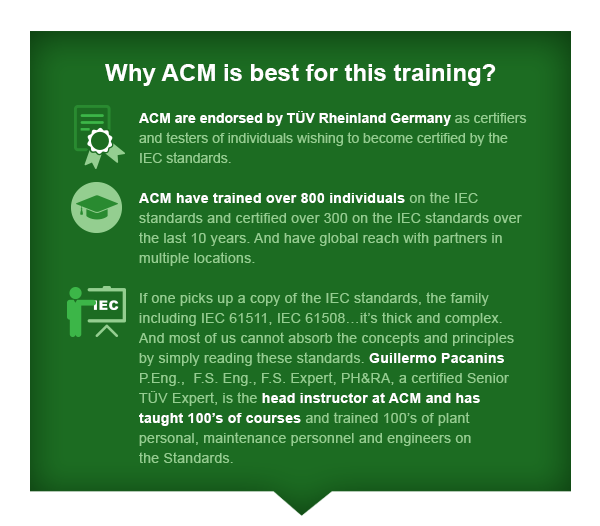Are you up to date with the IEC 61511 standards Edition 2? Sign up today for either our TUV 4.5 day (September 18 – 22nd ) or TUV 1 day (September 28th) course.
What are your options?
Offered five times, one-day public courses are scheduled for anyone who wants to understand the purpose and differences involved with the recent edition of IEC 61511 Edition 2. The course is also designed to get you up-to-date and as a general information course.
Available course dates: September 28th, October 19th and November 28th
Offered twice, four and a half-day courses are available to qualified individuals to become certified under TÜV (Rheinland) as TÜV practitioner or TÜV F.S. ENG.
Available Course Date: September 18 - 22nd
Private one-day courses are available for any plant who wants to understand the purpose and differences involved with the recent edition of IEC 61511 Edition 2. The course is also designed to get you up-to-date and as a general information course.
- A minimum equivalent charge for (6) students plus travel and expense applies.
- The private course requires (2) week advanced booking notice.
- Multiple plants can be coordinated to capture more than one plant at a time.
TO SCHEDULE A PRIVATE TRAINING COURSE, CALL 403.264.9637
Why Now?
NEW STANDARDS issued recently - Individuals previously certified by TÜV (Rheinland) or CFSE should be up to date with the new standards.
NO FORGIVENESS Owners must abide with new standards - There is no grace period overlooking IEC Safety Standards IEC 61511 Edition 2, as the grandfather clause has not been included.

Why are the standards important for plant managers and owners?
Instrument & Controls (I&C) accounts for approx. 65% of total plant risk reduction and can easily be a threat when improperly designed for Risk Reduction. I&C safeguards (alarms, indicators, trips, Safety Instrument Systems) are unregulated and much more complex to design, change or maintain than a mechanical safeguard i.e. PSV’s.
If you have an SIS system in your facility, it's the law in many countries and it's the only standard globally to help anyone design an Instrumented Safety System.
Countries and Owners have, in general, agreed to IEC standards as the Global standard for implementing I&C in a Safety Instrumented System (SIS).
Why are IEC standards important for individuals, maintenance, engineers and operations leaders?
Enables you to support plants using I&C and SIS systems to reduce your risk.
Provides a foundational layer of understanding of how can I&C systems reduce risk in facilities.
Makes you a valuable member of any design, maintenance and operations team with current standards and practices.
Want to read more ACM articles?
